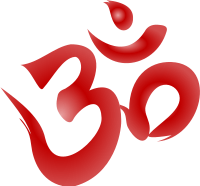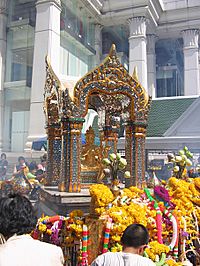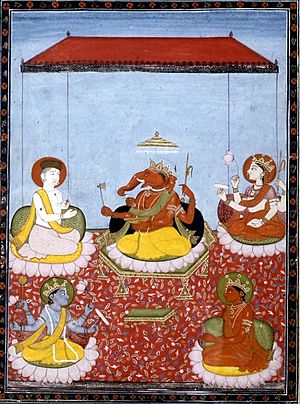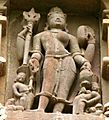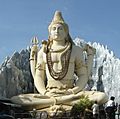Hinduism facts for kids
Hinduism is an ancient way of life and a religion. It is mostly practiced in South Asia, especially in India and Nepal. Many Hindus call their religion Sanātana Dharma, which means "the eternal way" or "eternal tradition." They believe it has always existed, even before recorded history.
Experts see Hinduism as a mix of many different Indian cultures and traditions that have grown over a very long time. It does not have one single founder, and its exact beginnings are not known. Some of its roots can be seen in ancient cave paintings from around 30,000 BCE in India. Hinduism as a religion really started to grow between 500 BCE and 300 CE, after a period called the Vedic period.
Hinduism includes many different ideas and beliefs. These are connected by shared concepts like rituals, ideas about the universe, sacred texts, and journeys to holy places. Hindu texts are split into two main types: Śruti ("heard") and Smṛti ("remembered"). These books talk about philosophy, stories of gods, Vedic ceremonies, Yoga, and temple building. Important scriptures include the Vedas, Upanishads, the Bhagavad Gita, and the Agamas.
Hindus believe in four main goals for human life: Dharma (doing your duty), Artha (gaining wealth), Kama (enjoying life's pleasures), and Moksha (finding freedom). Other key ideas are karma (actions and their results), Saṃsāra (the cycle of rebirth), and different Yogas (paths to reach freedom). Hindu practices include puja (worship), meditation, family ceremonies, yearly festivals, and occasional pilgrimages. Some Hindus choose to leave their normal lives to become sanyasi (holy people) to find Moksha. Hinduism teaches important duties like honesty, non-violence (ahimsa), patience, and kindness. The four biggest groups in Hinduism are Vaishnavism, Shaivism, Shaktism, and Smartism.
Hinduism is the third largest religion in the world. About 1.15 billion Hindus live around the globe, making up 15-16% of the world's population. Most Hindus live in India, Nepal, and Mauritius. Many Hindus also live in other countries.
Beliefs
Hindu beliefs include Dharma (ethics and duties), Samsāra (the endless cycle of birth, life, death, and rebirth), Karma (the idea that every action has a reaction), Moksha (freedom from the cycle of rebirth), and various Yogas (different paths or practices).
Purusharthas (Goals of Human Life)
Hinduism accepts four main goals for human life. These are Dharma, Artha, Kama, and Moksha. They are known as the Puruṣārthas.
Dharma (Righteousness and Duty)
Dharma is seen as one of the most important goals in Hinduism. It is believed that Dharma helps the universe and life continue. It includes duties, good qualities, and the "right way to live." Hindu Dharma covers religious duties, moral rights, and what helps society stay in order. The Brihadaranyaka Upanishad says:
Nothing is higher than Dharma. The weak overcomes the stronger by Dharma, as over a king. Truly that Dharma is the Truth (Satya); Therefore, when a man speaks the Truth, they say, "He speaks the Dharma"; and if he speaks Dharma, they say, "He speaks the Truth!" For both are one.
—Brihadaranyaka Upanishad, 1.4.xiv
In the Mahabharata, Krishna says that Dharma holds together both worldly and spiritual matters. The word Sanātana means eternal or forever. So, Sanātana Dharma means it is the duty that has no beginning or end.
Artha (Livelihood and Wealth)
Artha is the second goal of life in Hinduism. It means seeking wealth for living and for economic success. This includes political life, diplomacy, and being well-off. Artha covers all "means of life," activities, and resources that help a person achieve their desired state. It includes wealth, career, and financial safety. The goal of Artha is considered important in Hindu life.
Kāma (Sensual Pleasure)
Kāma (Sanskrit, Pali; Devanagari: काम) means desire, wish, passion, and pleasure of the senses. It also means enjoying life, affection, or love. In Hinduism, Kama is seen as an important and healthy goal. However, it should be followed without giving up Dharma, Artha, and Moksha.
Mokṣa (Liberation and Freedom)
Moksha (Sanskrit: मोक्ष mokṣa) or mukti (Sanskrit: मुक्ति) is the highest and most important goal in Hinduism. In some Hindu schools, Moksha means freedom from sadness, suffering, and the cycle of Saṃsāra (birth-rebirth). In other schools, like the monistic ones, Moksha means "self-realization." This means understanding that the whole universe is part of your true self.
Karma and Samsara
Karma means action or deed. It also refers to the idea that every action has a result. This idea combines:
- Cause and effect, which can be moral or not.
- The belief that good or bad actions have consequences.
- The idea of rebirth.
The Karma theory suggests that a person's current experiences are due to their past actions. These actions might be from their current life or, in some Hindu beliefs, from past lives. This cycle of birth, life, death, and rebirth is called samsara. Getting free from samsara through moksha is believed to bring lasting happiness and peace. Hindu scriptures teach that your future depends on your current actions and past deeds.
Moksha
The main goal of life in Hinduism is moksha, nirvana or samadhi. However, different Hindu schools understand it in different ways. For example, Advaita Vedanta says that after reaching moksha, a person understands their "soul" or "self" and sees it as one with Brahman (the ultimate reality). Followers of Dvaita (dualistic) schools believe that after moksha, a person's "soul" is different from Brahman but very close to it. They believe one will spend eternity in a loka (higher place). For some schools, moksha is freedom from samsara. For others, like the monistic school, moksha can be achieved in this life and is a state of mind.
Concept of God
Hinduism is very diverse. It includes beliefs like monotheism (one god), polytheism (many gods), panentheism (God is in everything and beyond it), pantheism (God is everything), monism (all reality is one), and even atheism. It really depends on what each person chooses to believe. This is why Hinduism is sometimes called henotheistic. This means people might worship one main god while still accepting that other gods exist. But any single term is too simple to describe it fully.
|
|
||||||
Hindus believe that all living things have a soul. This soul, or true "self," of every living being is called the ātman. The soul is believed to live forever. In some Hindu beliefs (like Advaita Vedanta), this Atman is the same as Brahman (the supreme soul). The goal of life, according to Advaita, is to realize that your soul is the same as the supreme soul. This means understanding that the supreme soul is in everything and everyone, and that all life is connected.
Dualistic schools (like Dvaita and Bhakti) see Brahman as a Supreme Being separate from individual souls. They worship the Supreme Being as Vishnu, Brahma, Shiva, or Shakti, depending on their group. God is called Ishvara, Bhagavan, Parameshwara, Devadu or Devi. These terms have different meanings in different Hindu schools. Devi is usually used when talking about a female goddess.
Hindu scriptures also mention heavenly beings called Devas (or devī for females). These are like demi-gods or heavenly beings. Devas are a big part of Hindu culture. They appear in art, buildings, and stories, especially in Indian epic poetry and the Puranas. They are often seen as different from Ishvara, who is a personal god. Many Hindus worship Ishvara in one of its forms as their iṣṭa devatā, or chosen ideal. This choice is up to each person, and also depends on local and family traditions. The many Devas are seen as different ways that Brahman appears.
Main Traditions
Hinduism does not have one main leader or authority. Hindus do not always say they belong to a specific group. However, there are four main groups in Hinduism: Vaishnavism, Shaivism, Shaktism, and Smarthism.
Vaishnavism is the tradition that worships Vishnu and his avatars, like Krishna and Rama. People in this group often do not live like monks. Their practices include community dancing and singing of Kirtans and Bhajans. Some believe that sound and music have spiritual power.
Shaivism focuses on Shiva. Shaivas are often more interested in individual spiritual practices. This group has several sub-schools. They practice devotion like Bhakti, but also focus on philosophy like Advaita and Yoga. Some Shaivas worship in temples, while others practice yoga to become one with Shiva inside themselves. Shaivas sometimes see God as half male and half female, combining male and female energies (Ardhanarishvara). Shaivism is connected to Shaktism, where Shakti is seen as Shiva's wife. Shaivism is mainly practiced in the Himalayan north, from Kashmir to Nepal, and in south India.
Shaktism focuses on worshipping the goddess Shakti or Devi as the cosmic mother. It is mainly practiced in northeastern and eastern states of India, like Assam and Bengal. Devi is shown in gentle forms like Parvati, Shiva's wife, or as warrior goddesses like Kali and Durga. Community celebrations include festivals, some of which have parades and involve putting idols into the sea or other water bodies.
Smartism worships all the main Hindu deities, including Shiva, Vishnu, Shakti, Ganesha, Surya, and Skanda. The Smarta tradition grew during the early Classical Period of Hinduism, around the start of the Common Era. This was when Hinduism developed from a mix of older traditions. The Smarta tradition is very similar to Advaita Vedanta. It considers Adi Shankara as its founder. This tradition believes that worshipping God with qualities (saguna Brahman) is a journey toward understanding God without qualities (nirguna Brahman, Atman, or Self-knowledge).
Hindu Texts
Hindu texts are some of the oldest in the world. They were written in Sanskrit and Tamil. The oldest text is the Rig Veda, which is about 4000 years old. Hindu texts are divided into two parts:
- Shruti (what is heard)
- Smriti (what is remembered)
Shruti
Shruti (Sanskrit: श्रुति; IAST: Śruti) means "that which is heard." These are ancient religious texts that form the main core of Hinduism. They include the four Vedas and their four types of attached texts: the Samhitas, the Brahmanas, the Aranyakas, and the early Upanishads.
Smriti
Smriti (Sanskrit: स्मृति, IAST: Smṛti), means "that which is remembered." These are Hindu texts that were remembered and passed down by word of mouth from one generation to the next. Smriti includes the great epics (Mahābhārata and Rāmāyana), the Dharmasūtras and Dharmaśāstras, the Arthasaśāstras, the Purānas, and Kāvya (poetical literature).
Festivals
Many Hindu festivals are celebrated around the world, especially in India and Nepal. These festivals involve worship, offerings to gods, fasting, rituals, fairs, charity, and celebrations. The festivals mainly celebrate events from Hindu stories, changes in seasons, or changes in the solar system. Different groups celebrate different festivals. However, festivals like Diwali, Holi, Shivratri, Raksha Bandhan, and Janamashtmi are celebrated by most Hindus.
History
Origins of Hinduism
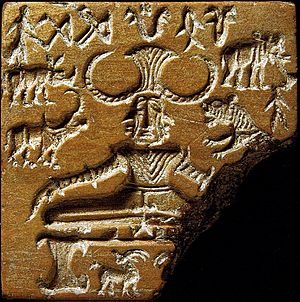
The exact origins of Hinduism are not known. However, the earliest signs of Hindu practices come from the Mesolithic period. These include rock paintings from places like the Bhimbetka rock shelters, which are about 30,000 years old or even older. Some religious practices might have started around 4000 BCE.
Varna
The Varna system, which later became the caste system during British rule, showed how strongly people felt about everyone following their own dharma, or destined path. Many Hindus say the caste system goes against the true meaning of dharma. However, Varna did play a big role in Hindu society. Its later change into the Caste system by the British lost favor and became illegal after India gained independence.
Temples
Puja (worship) takes place in the Mandir (temple). Mandirs can be small village shrines or large buildings with walls around them. People can visit the Mandir at any time to pray and join in bhajans (religious songs). Hindus also worship at home and often have a special room with a shrine to particular gods.
Temple building in India began nearly 2000 years ago. The oldest temples, made of brick and wood, no longer exist. Stone later became the preferred material. Temples marked a change in Hinduism. It moved from the Vedic religion of ritual sacrifices to a religion of Bhakti, which means love and devotion to a personal god. Temple building and worship methods are guided by ancient Sanskrit scriptures called Agamas. There are many Agamas, each dealing with different gods. Temples in different parts of India have big differences in their architecture, customs, rituals, and traditions. During a temple's special opening ceremony, the presence of the universal Brahman is called into the main stone statue of the temple. This ritual makes the statue and the temple sacred and divine.
Ways of Worship
The Bhakti Schools
The Bhakti (Devotional) school gets its name from a Hindu term. It means a joyful, selfless, and strong love for God. God can be seen as a beloved Father, Mother, Child, or any relationship that feels right to the worshipper. Bhakti philosophy tries to connect with the divine through a personal form. This explains why there are so many gods and goddesses in India. They often reflect the specific beliefs of small regions or groups of people.
Bhakti is seen as a form of Yoga, or union. It aims to let go of the ego in God. This is because thinking of the body and limited mind as the self is seen as a barrier to spiritual understanding. In Bhakti, it is believed that God causes all changes and is the source of all good deeds. God acts through the worshipper as love and light. It is said that a worshipper's "sins" and wrongdoings disappear on their own through the love of God.
The most common way to show love for God in Hinduism is through puja, or ritual devotion. This often uses a murti (statue) along with singing or chanting special prayers called mantras.
Devotional songs called bhajans (written mostly from the 14th-17th centuries), kirtan (praise), and arti (a simpler form of Vedic fire ritual) are sometimes sung during puja. This way of devotion helps people connect with God through symbols. However, it is said that a bhakta (devotee), through a growing connection with God, eventually does not need any outside forms. They become fully immersed in the joy of pure Love and Truth.
Bhakti led to a lot of devotional literature, music, and art that has enriched the world. It gave India new spiritual energy, moving away from unnecessary rituals and old social rules. You can learn more at bhakti yoga.
Important Hindu Symbols and Ideas
Ahimsa and the Cow
Many Hindus are vegetarians (they do not eat meat) because they respect all life. About 30% of Hindus today, especially in traditional communities in South India, some northern states like Gujarat, and many Brahmin areas, are vegetarian.
Most Hindus who do eat meat do not eat beef. Some do not even use leather products. This is likely because Hindus have relied so much on cows for dairy products, plowing fields, and fertilizer. Because of this, the cow's role as a helpful "caretaker" of humanity grew. It became seen as almost a motherly figure. So, while most Hindus do not worship the cow, and rules against eating beef came long after the Vedas were written, the cow still has an honored place in Hindu society. It is said that Krishna is both Govinda (herder of cows) and Gopala (protector of cows), and Shiva's helper is Nandi, the bull. Because of the focus on vegetarianism (which meat-eating Hindus often follow on religious days) and the sacred nature of the cow, many holy cities in India ban selling meat. There is also a movement among Hindus to ban cow slaughter across all of India.
Hindu Symbols
Hindus use many symbols and signs. The two most important symbols are the "Aum" and the "Swastika (Hinduism)".
Forms of Worship: Murtis and Mantras
Contrary to what some people think, Hinduism is not strictly about one god or many gods. The different Hindu gods and avatars that Hindus worship are understood as different forms of one truth. This truth is sometimes seen as beyond a simple god, as a formless Divine Ground (Brahman), similar to monism. Or it can be seen as one main god like Vishnu or Shiva.
Whether they believe in the One source as formless (nirguna Brahman, without qualities) or as a personal god (saguna Brahman, with qualities), Hindus understand that the one truth can be seen differently by different people. Hinduism encourages people to describe and build a personal connection with their chosen deity (ishta devata) in the form of a god or goddess.
While some counts suggest that worshippers of Vishnu (called Vaishnavs) make up 80% and those of Shiva (called Shaivaites) and Shakti make up the remaining 20%, these numbers can be misleading. Most Hindus worship many gods as different colors of the same truth. Among the most popular are Vishnu (as Krishna or Rama), Shiva, Devi (the Mother, appearing as many female deities like Lakshmi, Saraswati, Kali, and Durga), Ganesha, Skanda, and Hanuman.
Worship of these deities is often done with the help of pictures or statues (murti). These are not seen as God themselves, but as ways for the worshipper's mind to connect. They are symbols of a greater principle, representing the endless love and greatness of God. They are never thought to be the actual god or idea. So, Hindu image worship is a form of venerating symbols of divinity, not worshipping idols themselves. For more details, see murti.
Mantra
Hindus use several prayers and groups of words. Some groups of words are called mantras. These words are said to help the speaker focus more deeply and gain understanding, bringing them closer to Brahman. A well-known mantra is om or aum. It symbolizes Brahman and is often the first word in many prayers. To say a mantra well, you should say it slowly and in a deep voice.
Geographic Distribution
The nations of India, Mauritius, and Nepal, as well as the Indonesian island of Bali, have more Hindus than people of other religions. In these countries, especially Nepal and India, Hinduism is very popular. These countries also have many Hindus:
- Bangladesh (12 million)
- Sri Lanka (2.5 million)
- the United States (2.0 million)
- Pakistan (3.3 million)
- South Africa (1.2 million)
- the United Kingdom (1.2 million)
- Malaysia (1.1 million)
- Canada (0.7 million)
- Fiji (0.5 million)
- Trinidad and Tobago (0.5 million)
- Guyana (0.4 million)
- the Netherlands (0.4 million)
- Singapore (0.3 million)
- Myanmar (0.3 million)
- Suriname (0.2 million)
- Australia (0.1 Million)
There are also strong Hindu communities in countries of the former Soviet Union, especially in Russia and Poland. The Indonesian islands of Java, Sulawesi, Sumatra, and Borneo also have large native Hindu populations. Through its Yoga practices, Hinduism is even more widespread globally.
Images for kids
-
Swami Vivekananda helped introduce Vedanta and Yoga to Europe and the United States. He also helped people understand different faiths and made Hinduism a world religion.
-
Ganesha is one of the most famous and worshipped gods in the Hindu pantheon.
-
The Hare Krishna group at the Esplanadi Park in Helsinki, Finland
-
The Rigveda is the first of the four Vedas and one of the oldest religious texts. This Rigveda manuscript is in Devanagari.
-
The festival of lights, Diwali, is celebrated by Hindus all over the world.
-
Hindus in Ghana celebrating Ganesh Chaturti.
-
Holi celebrated at the Sri Sri Radha Krishna Temple in Utah, United States.
-
Priests performing Kalyanam (marriage) of the holy deities at Bhadrachalam Temple, in Telangana. This is one of the temples in India where Kalyanam is done every day.
-
A statue of Lord Shiva in yogic meditation.
-
Kauai Hindu monastery on Kauai Island in Hawaii is the only Hindu Monastery in North America.
-
A sadhu in Madurai, India.
-
The Hindu Shore Temple at Mahabalipuram was built by Narasimhavarman II.
See also
 In Spanish: Hinduismo para niños
In Spanish: Hinduismo para niños


